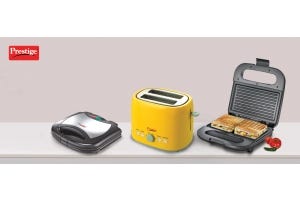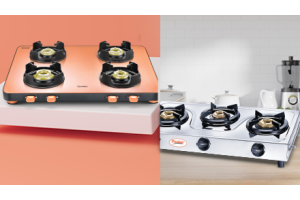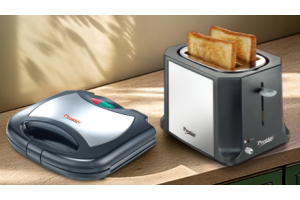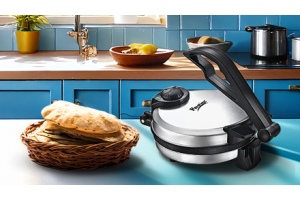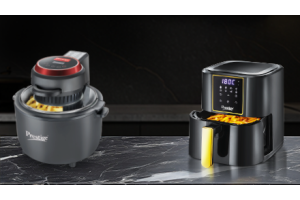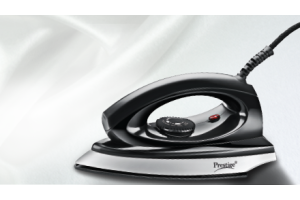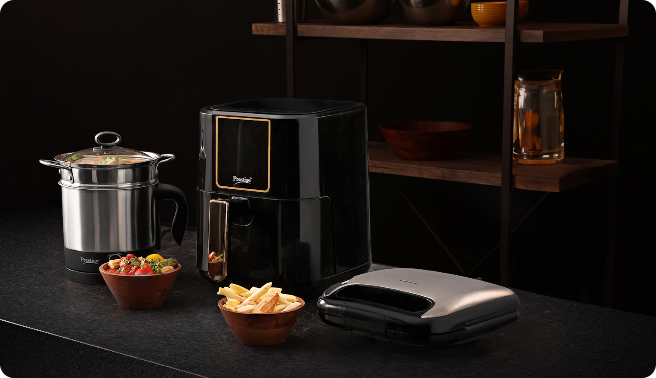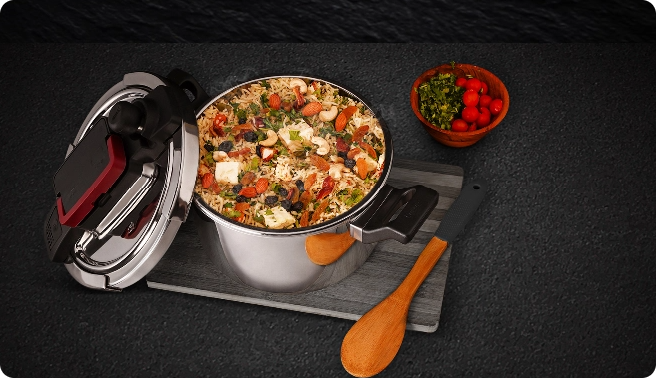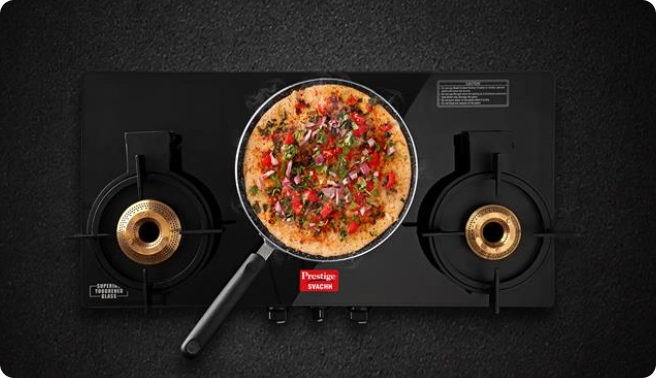When it comes to quick breakfasts or snacks, toasters and sandwich makers are top contenders. Though both handle bread-based meals, choosing the right one can be confusing. If you’re unsure whether to go for a toaster or a sandwich maker, you’re not alone.
This guide breaks down their key differences, unique features, and helps you decide which suits your kitchen best—whether you're a student, a busy professional, or upgrading your breakfast routine.
What is a Toaster?
A toaster is an electric kitchen appliance that browns bread slices using radiant heat. It transforms plain bread into crispy, golden toast with adjustable browning levels to suit personal preferences. Modern toasters can handle various types of bread—from sandwich slices to thick artisanal loaves, bagels, offering versatility for diverse breakfast needs.
Toasters work by using internal electric heating elements that emit radiant heat when powered on. When you place bread into the slots and lower the lever, the toaster activates these coils to heat up and toast the bread evenly on both sides. Most toasters come with adjustable browning controls, reheat and defrost functions, and automatic pop-up mechanisms for added convenience. Thanks to consistent heat distribution and easy operation, they’re a staple in homes for quick, reliable breakfast preparation.
Types of Toasters
Understanding the different types of toasters available can help you choose the right one for your needs. From simple daily use to versatile kitchen solutions, toasters come in various forms, each with unique features and capabilities.
- Pop-up Toasters: These are the most commonly used toasters in Indian households. They allow you to place bread into slots, select your desired browning level, and automatically pop the toast up when done. Compact and easy to use, models like the Prestige Pop-up Toaster PPTPKY offer features such as 6 browning levels, reheat/defrost functions, slide-out crumb trays, and auto shut-off for safety—making everyday toasting simple and mess-free.
- Toaster Ovens: Larger and more versatile, toaster ovens are ideal for those who want more than just toast. They can bake, broil, reheat, and toast a variety of foods, functioning almost like a mini oven. The Prestige Oven-Toaster-Grill POTG 19 PCR comes with a 19-litre capacity, rotisserie function, adjustable temperature control, and a drop-down crumb tray—perfect for grilling paneer tikka, baking small cakes or roasting vegetables with ease.
- Electric Grills (Multi-purpose Toasters): Though not traditional toasters, electric grills like the Prestige PEG 4.0, PEG 1.0, and PEG 7 offer excellent toasting and grilling capabilities. These appliances come with features such as floating hinges, detachable oil collectors, temperature control knobs, and non-stick aluminium plates—making them ideal for oil-free sandwiches, grilled vegetables, and even quick BBQ-style meals at home.
- Sandwich Toasters: Tailored for stuffed or layered breads, sandwich toasters like the Prestige PSMFD 01 are perfect for making crispy, oil-free sandwiches. They feature fixed non-stick plates, heat-resistant bodies, and power indicators. These toasters are great for quick, mess-free snacks or breakfast options without needing oil or butter.
- Conveyor Toasters (Commercial Use): Primarily used in restaurants or commercial kitchens, conveyor toasters toast bread continuously using a belt system. They're ideal for high-volume needs but are not suited for home use.
- Specialty Toasters: These include long-slot toasters for artisanal breads, wide-slot toasters for bagels, or models with “lift-and-look” and “bagel” settings. They are designed to offer more control and flexibility, catering to varied lifestyle preferences.
Common Foods to Toast
While bread remains the primary food item for toasting, modern toasters can handle a surprising variety of foods. Understanding what you can toast helps maximize your appliance's utility and provides more meal options.
Traditional bread varieties work excellently in toasters, including white bread, whole wheat, multigrain, and sourdough. The key is ensuring the bread slices fit properly in the toaster slots without being too thick or too thin for even heating.
Bagels are popular toasting options that many toasters accommodate with special settings. These denser bread products require slightly different heating approaches to achieve proper toasting without burning.
Pastries and specialty items like Pop-Tarts, toaster strudels, and frozen waffles can be prepared in toasters, though it's important to check manufacturer guidelines to avoid damaging the appliance or creating safety hazards.
Artisanal and thick breads require toasters with wider slots and adjustable settings to accommodate varying thicknesses while ensuring even browning throughout.
What is a Sandwich Maker?
A sandwich maker is a compact kitchen appliance that heats and presses sandwiches between two hinged plates, sealing the edges and evenly cooking the contents. Unlike regular toasters, sandwich makers create hot, ready-to-eat meals by applying both heat and pressure, ideal for grilled cheese, paninis, and even breakfast items like French toast.
Sandwich makers typically feature non-stick plates and indicator lights for ease of use. Models like those from TTK Prestige combine convenience and versatility, making them great for quick, mess-free meals with minimal cleanup.
Types of Sandwich Makers
The variety of sandwich makers available caters to different cooking preferences and household needs. Understanding these types can help you select the best option for your kitchen.
- Basic Sandwich Makers: These models come with fixed heating plates and simple on/off functionality, perfect for quick, no-fuss sandwiches. Affordable and compact, they suit small families or occasional users. The Prestige PSMFD 01 Sandwich Toaster, with its durable die-cast plates and non-stick coating, is a reliable example of this category, ideal for everyday, oil-free toasting.
- Grill Sandwich Makers: These appliances feature rigid plates that give sandwiches attractive grill marks while ensuring even heat distribution. They also help drain excess oil for healthier cooking. Models like the Prestige PEG 1.0 Electric Grill and PEG 4.0 double as sandwich and grill makers, offering larger surfaces, temperature control knobs, and floating hinges for a perfect fit—making them great for gourmet-style grilled sandwiches.
- Multi-function Sandwich Makers: These versatile devices come with interchangeable plates, allowing you to switch between sandwich making, grilling, and even waffle making. While Prestige doesn’t currently offer models with interchangeable plates, its electric grills, like the PEG 7, provide multifunctional performance by letting you grill various dishes, beyond just sandwiches, thanks to features like adjustable floating plates and non-stick coating.
- Panini Makers: Specifically built for pressed, deli-style paninis, these machines usually have larger surfaces and apply greater pressure. While Prestige’s electric grills (such as PEG 1.0 and PEG 7) aren’t marketed strictly as panini makers, their robust build, floating hinges, and precise temperature control deliver similar results—ideal for panini lovers looking for café-style outcomes at home.
Foods You Can Prepare
Sandwich makers offer impressive versatility in food preparation, extending far beyond basic sandwiches. Understanding the range of foods you can prepare helps maximize your appliance investment and provides diverse meal options.
- Classic sandwiches form the foundation of sandwich maker use, including grilled cheese, ham and cheese, club sandwiches, and various meat and vegetable combinations. The key is ensuring fillings aren't too thick or wet, which could prevent proper sealing or create messes.
- International specialties like paninis, quesadillas, croque monsieurs, and toasted subs can be easily prepared. These dishes benefit from the even heating and pressure that sandwich makers provide, creating authentic textures and flavors.
- Breakfast items represent an often-overlooked category. French toast, breakfast sandwiches with eggs and bacon, hash brown patties, and even some pancake batters can be cooked in sandwich makers with proper technique.
- Creative preparations include dessert sandwiches with fruit and cream cheese, pizza pockets using tortillas, and even some meat patties or vegetable fritters. The versatility largely depends on your creativity and willingness to experiment.
Key Differences Between Toaster & Sandwich Maker
Understanding the fundamental differences between toasters and sandwich makers helps clarify which appliance better suits your needs. These differences span functionality, versatility, and intended use cases.
- Primary Function Differences: The toaster vs sandwich maker debate often centers on basic functionality. Toasters excel at browning and crisping bread through radiant heat, while sandwich makers combine ingredients into complete meals through heat and pressure. This fundamental difference affects how each appliance integrates into your cooking routine.
- Cooking Method Variations: Toasters use radiant heat from coils or elements to brown bread surfaces, while sandwich makers use conductive heat from direct plate contact combined with pressure. This creates different textures and results, with toasters producing crispy surfaces and sandwich makers creating pressed, sealed meals.
- Versatility Scope: Sandwich maker types generally offer more versatility in meal preparation compared to toasters. While toasters primarily handle bread-based items, sandwich makers can accommodate complete meals with multiple ingredients, making them more suitable for users seeking diverse cooking options.
- Time and Convenience Factors: Toasters typically work faster for simple bread toasting, usually completing tasks in 2-3 minutes. Sandwich makers require slightly longer cooking times, typically 4-6 minutes, but produce complete meals rather than just toasted bread.
- Space and Design Considerations: Toasters generally have smaller footprints and vertical designs, while sandwich makers require more counter space due to their hinged, horizontal layout. This difference matters in compact kitchens where space efficiency is crucial.
Advantages of a Toaster
Toasters offer several compelling advantages that make them valuable additions to many kitchens. Understanding these benefits helps determine whether a toaster aligns with your cooking needs and lifestyle preferences.
- Speed and Efficiency: Advantages of a Toaster include rapid meal preparation, with most toasting tasks completed in 2-3 minutes. This speed makes toasters ideal for busy mornings when quick breakfast preparation is essential. The efficiency extends to energy consumption, as toasters use relatively little electricity for their brief operating periods.
- Simplicity and Ease of Use: Toasters require minimal learning curves and offer straightforward operation. Most models feature simple dial controls or push-button interfaces that anyone can master quickly. This simplicity makes them accessible to all family members regardless of cooking experience.
- Consistent Results: Modern toasters provide reliable, repeatable results through precise temperature control and timing mechanisms. Once you determine your preferred browning level, you can expect consistent results with each use, eliminating guesswork and reducing waste from over- or under-toasted bread.
- Compact Design: Toasters occupy minimal counter space while providing essential functionality. Their vertical design and compact footprint make them suitable for small kitchens, dorm rooms, or offices where space efficiency matters.
- Low Maintenance: Toasters require minimal cleaning and maintenance compared to more complex appliances. Regular crumb tray emptying and occasional exterior wiping keep most toasters functioning optimally for years.
- Cost-Effectiveness: Basic toasters represent affordable appliance investments with low operating costs. They provide excellent value for users who primarily need bread toasting capabilities without additional features.
Disadvantages of a Toaster
While toasters offer numerous benefits, they also present certain limitations that potential buyers should consider. Understanding these drawbacks helps set realistic expectations and informs purchasing decisions.
- Limited Functionality: Disadvantages of a Toaster include restricted cooking capabilities compared to multi-function appliances. Toasters primarily handle bread toasting and cannot accommodate complete meal preparation or diverse cooking tasks that some users prefer.
- Size Restrictions: Most toasters accommodate standard bread slice sizes, limiting users to specific bread types and thicknesses. Artisanal breads, thick slices, or unusual shapes may not fit properly, restricting meal variety for users who prefer diverse bread options.
- Single-Purpose Design: Unlike versatile kitchen appliances, toasters serve primarily one function, which may not justify counter space in kitchens where multi-functionality is prioritized. Users seeking appliances that handle multiple cooking tasks might find toasters too specialized.
- Potential for Uneven Toasting: Some toasters struggle with consistent browning, particularly less expensive models. Uneven heating elements or poor design can result in bread that's darker on one side than the other, affecting both appearance and taste.
- Limited Ingredient Integration: Toasters cannot combine multiple ingredients into complete meals, requiring users to prepare toppings or accompaniments separately. This limitation affects convenience for users who prefer one-step meal preparation.
Advantages of a Sandwich Maker
Sandwich makers provide unique benefits that appeal to users seeking versatile, convenient meal preparation solutions. These advantages often make them attractive alternatives or additions to traditional cooking methods.
- Meal Completion Capability: Advantages of a Sandwich Maker include the ability to create complete, satisfying meals in a single appliance. Unlike toasters that only prepare bread, sandwich makers combine multiple ingredients into finished dishes, providing better value for meal preparation time and effort.
- Versatility in Food Preparation: Sandwich makers handle diverse ingredients and cooking styles, from simple grilled cheese to complex paninis with multiple components. This versatility makes them suitable for breakfast, lunch, dinner, and snack preparation, maximizing their utility value.
- Even Heat Distribution: The dual-plate design ensures consistent heating throughout the sandwich, eliminating cold spots or unevenly cooked areas that can occur with stovetop preparation. This even heating contributes to better taste and food safety.
- Mess-Free Cooking: Sealed edges prevent ingredients from spilling out during cooking, reducing cleanup requirements and ingredient waste. The contained cooking environment keeps counters and surrounding areas cleaner compared to open-pan cooking methods.
- Time Efficiency for Complex Meals: While individual toasting might be faster, sandwich makers prove more efficient when preparing complete meals. The ability to cook multiple components simultaneously saves overall meal preparation time.
- Creative Cooking Opportunities: Sandwich makers encourage culinary experimentation with different ingredient combinations, cooking techniques, and meal styles that wouldn't be possible with basic toasters.
Disadvantages of a Sandwich Maker
Despite their versatility, sandwich makers also present certain limitations that users should consider before purchasing. Understanding these drawbacks helps ensure realistic expectations and appropriate appliance selection.
- Longer Cooking Times: Disadvantages of a Sandwich Maker include extended cooking periods compared to simple toasting. Complete sandwiches typically require 4-6 minutes to cook properly, which may not suit users prioritizing speed over meal complexity.
- Size and Storage Requirements: Sandwich makers generally require more counter space and storage room than compact toasters. Their hinged design and larger footprint can be challenging in small kitchens where space efficiency is crucial.
- Cleaning Complexity: The ridged or textured plates that create attractive grill marks can be challenging to clean thoroughly. Food particles may stick in grooves, requiring more attention and time for proper maintenance compared to simple toaster crumb trays.
- Limited Bread Size Flexibility: Most sandwich makers accommodate standard bread sizes, potentially limiting users who prefer larger artisanal breads or unusual shapes. The fixed plate dimensions restrict creativity in bread selection.
- Power Consumption: Sandwich makers typically consume more electricity than toasters due to longer cooking times and dual heating plates. This increased energy usage can impact electricity bills for frequent users.
- Learning Curve for Optimal Results: Achieving perfect sandwiches requires understanding proper ingredient quantities, cooking times, and heat settings. New users may experience failures while learning optimal techniques.
Which One Should You Choose?
Selecting between a toaster and sandwich maker depends on your specific needs, cooking habits, and kitchen priorities. Which sandwich maker is good or whether a toaster better suits your needs requires honest assessment of your meal preparation preferences and lifestyle factors.
- Consider Your Meal Preparation Style: If you primarily need quick bread toasting for breakfast with separate topping preparation, a toaster provides optimal efficiency. However, if you prefer complete, hot meals with minimal preparation steps, sandwich makers offer better value and convenience.
- Evaluate Your Time Constraints: Busy professionals who need rapid breakfast solutions might prefer toasters for their speed and simplicity. Conversely, users with slightly more time who value meal variety and completion might find sandwich makers more satisfying.
- Assess Your Kitchen Space: Compact kitchens with limited counter space favor toasters' smaller footprints. Larger kitchens can accommodate sandwich makers' space requirements while benefiting from their increased functionality.
- Consider Your Family Size and Needs: Large families might benefit from 4-slice toasters for efficiency, while smaller households could find sandwich makers more practical for creating varied, complete meals for fewer people.
- Budget Considerations: Basic toasters offer lower initial costs and operating expenses, while sandwich makers require higher initial investments but provide greater meal variety and completion capabilities.
- Long-term Usage Patterns: Consider how each appliance fits into your long-term cooking goals and whether the features align with your evolving meal preparation preferences.
TTK Prestige offers excellent options in both categories, allowing you to choose based on your specific requirements rather than being limited by product availability or quality concerns.
For more information you can also read How to choose sandwich maker
Conclusion
Choosing between a toaster and a sandwich maker depends on your cooking habits, lifestyle, and kitchen space. Toasters are quick, efficient, and ideal for simple bread toasting, while sandwich makers offer versatility for hot, filled meals. Many households find value in owning both—using toasters for daily breakfasts and sandwich makers for more filling options. With quality products from TTK Prestige in both categories, you can confidently select what suits your needs best.
Frequently Asked Questions (FAQs)
1) Can I make regular toast in a sandwich maker?
A) Yes, but it won’t match a toaster’s light, crispy finish. Sandwich makers press and seal the bread, creating a different texture and taking longer. For regular toast, a toaster is more efficient. However, if you prefer grilled-style toast, a sandwich maker can suffice.
2) Which TTK Prestige appliance suits a small family better?
A) It depends on your routine. For quick toast-based breakfasts, a pop-up toaster is ideal. But if you prefer hot, filling meals like grilled sandwiches, a sandwich maker offers more versatility—great for breakfast, lunch, or dinner.
3) Are sandwich makers harder to clean than toasters?
A) Generally, yes. Sandwich makers have ridged plates that need wiping, though non-stick coatings help. Toasters mostly need crumb tray cleaning. If minimal maintenance is key, toasters are easier, but sandwich makers are manageable with care.
4) Can sandwich makers cook more than just sandwiches?
A) Absolutely. You can make quesadillas, French toast, grilled veggies, patties, or even desserts. Just avoid overly wet or thick fillings. Prestige sandwich makers provide even heating, making them handy for creative cooking.
5) Which uses more electricity—sandwich maker or toaster?
A) Toasters use less power per use due to shorter run times. Sandwich makers take longer and use both plates, so they consume slightly more. Still, the monthly cost difference is small for most households.
6) Can I use thick artisanal bread in both appliances?
A) Only if the model supports it. Many standard appliances don’t handle thick bread well. Look for Prestige models with larger slots or deeper plates, or consider a toaster oven for thick or uneven slices.
7) What’s better for students or young professionals?
A) Toasters are compact, low-cost, and great for fast breakfasts. Sandwich makers offer more variety and can make full meals—ideal if you eat at home often. Choose based on how much and what type of cooking you plan to do.







